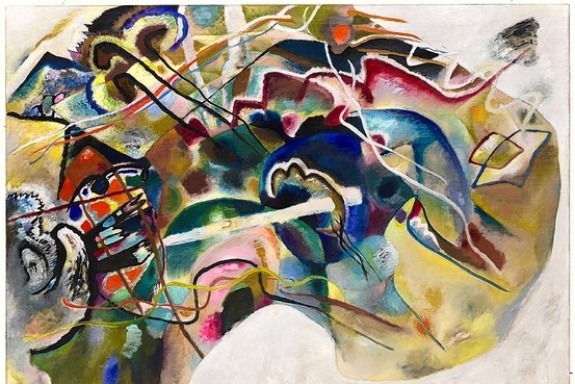An unexpected benefit of today's widespread reductions in museum funding is the proliferation of small exhibitions that make austerity an asset. Witness "Kandinsky and the Harmony of Silence: Painting With White Border" and "Stella Sounds: The Scarlatti K Series," at the Phillips Collection here, each a judicious, focused study of a specific aspect of a modern master of abstraction. Despite the differences between the two protagonists—the Russian-born Wassily Kandinsky (1866-1944) was exclusively a painter, while the American Frank Stella (born 1936) has long made wall-mounted constructions that test the boundaries between two- and three-dimensions—the exhibitions are complementary, as their related titles suggest. Kandinsky, a pioneer of abstract painting, is one of Mr. Stella's heroes and, if we look attentively, we discover fascinating affinities between the two artists' work.
"Kandinsky and the Harmony of Silence," organized jointly by the Phillips and the Solomon R. Guggenheim Museum, New York, centers on the Guggenheim's pivotal 1913 painting of the exhibition's subtitle and the Phillips's closely related 1913 canvas, "Sketch 1 for Painting With White Border." Kandinsky conceived the picture soon after he returned to his adopted city of Munich from an extended visit to Moscow. A group of watercolor and ink studies made in 1913, most from the Lenbachhaus und Kunstbau in Munich, allows us to follow Kandinsky as he strove to re-create what he described as the "extremely powerful impressions" of Moscow he received on his trip. We see him revisit particularly Russian motifs that had preoccupied him earlier—the rushing horses of a troika; an icon-derived, mounted St. George spearing the dragon—fragmenting the images into patches of color and emphatic sweeps of line. We watch as he compresses and expands compositional elements, changing the vertical of the Phillips's "Sketch 1" to the horizontal of the Guggenheim's larger picture. The dark, saturated palette and layered surface of "Sketch 1," testimony to many reworkings, are replaced by lighter, thinner, unrevised colors, clarified by the brushy white "surround" that gives the Guggenheim painting its name. This swelling border, added last, embraces all but the lower left corner of the centralized image, canceling out the lingering sense of rational space of "Sketch 1" and pushing the vestiges of the troika, St. George and a mountainous landscape firmly toward abstractness. The color white itself, according to Kandinsky, connotes "dead silence," emphasizing the center's Moscow-inspired multiplicity and chromatic cacophony.
A few slightly later works, from the Centre Georges Pompidou in Paris and the Guggenheim in New York, suggest the lasting reverberations of "Painting With White Border" within Kandinsky's work. Two canvases, from 1916 and 1920, make profitable use of neutral surrounding zones to enhance the complexities of their centers, while a 1915 watercolor reprises and expands the Guggenheim picture's horizontal composition, rendering the image even more open and abstract. A surprising inclusion is a freely painted gouache of a garden concert (c. 1911-12), by Kandinsky's companion during his Munich years, Gabriele Münter. Technical examination of the Phillips's and Guggenheim's paintings, illuminatingly documented in the show, not only revealed the many alterations to "Sketch 1" during its evolution, and the assured confidence with which Kandinsky approached the Guggenheim's painting, but also showed that "Sketch 1" was painted on Münter's abandoned canvas version of the gouache. Gift or appropriation?



